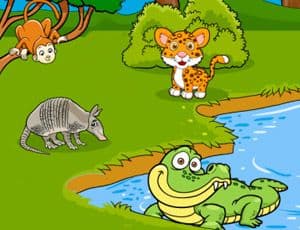Teacher's support sheet

Wild Animals
Hello fellow junglers!!
In this game we will meet several wild animals, but be careful, some can be extremely dangerous.
Slide the tracks to ride the wild animals and learn a little more about each of them!

Teacher's tips
Level of education: Elementary School
Age: 04 to 07 years old
For children, putting together a jigsaw puzzle is a challenge, as they need to order and fit all the pieces together to compose a picture. Through this search for solutions and alternatives, it is evident the development of important skills in several aspects: cognitive, motor, visual, social and others. An adventure that brings fun and development!
Learner outcomes
Develop motor skills;
Develop logical reasoning;
Analyze figures and expand the notions of composition and decomposition from the fragmentation of an image;
Develop discrimination and visual perception;
Knowing what wild animals are;
Understand the risk of some wild animals;
Know some species of wild animals and their main characteristics;
Teachers' goals
Work on logical reasoning, observation, critical and reflective analysis;
Evidence of discrimination and visual perception, through the analysis of the pieces and their positions in the puzzle;
Enable the development of different thinking skills, such as observation, comparison, analysis and the ability to synthesize;
Complement the study of wild animals;
Offer the game as a didactic resource to fix the content worked in the classroom;
Expand students' knowledge;
Work with students on motor skills
Work attention, concentration;
Suggestions of approaches for the teacher
(Suggestion 1) Divide the class into pairs and propose that they play, taking turns while assembling the puzzles. While a colleague mounts the image, the other makes the registration. Then they switch roles.
(Suggestion 2) Deliver the double copies of images of the animals that appear in the game: jaguar, tortoise, alligator, toucan, armadillo, tamarin and spider, to build conceptual maps (image of the animal in the center of the sheet and around it, arrows to direct information).
(Suggestion 3) When assembling the image of the animal, a text about the species appears, with information and curiosities. The student should record the information on the sheet, using their own words.
(Suggestion 4) In the classroom, deepen the study of these species, preparing a script with the children: “What do we want to know about them?”. Children should ask questions about what does not appear in the texts of the game.
Some suggested questions:
Who are your enemies?
How do you defend yourself?
How can you camouflage yourself in nature?
(Suggestion 5) Construction of a memory game with the animals and main information found in the game. The students themselves will have to build the game, in small groups, in the classroom.
(Suggestion 6) Introduce students to endangered animals and show the risks of hunting, animal trafficking and destruction of their habitat.
(Suggestion 7) Promote mime games where students should imitate a domestic animal so that classmates can guess.
(Suggestion 8) Ask students to make pictures illustrating with photographs the difference between domestic animals, domestic pets, wild animals, exotic animals.
(Suggestion 9) Schedule a lecture with the Fire Department addressing the subject “Risk of accidents with wild animals.
(Suggestion 10) Ask students to do research on the difference between crocodiles, alligators and alligators.
(Suggestion 11) Mime game. In this game, students must sit in a circle. One child at a time should get up and stand in the middle of the circle imitating an animal through mime. Sitting children must try to hit the animal.
More about the content
The numbers of endangered species in the world keep growing. Despite this, there is neither an official criterion nor a consensus that can define whether a species is endangered, endangered or extinct.
In order to base, at least a little, the classification, the International Union for Conservation of Nature and Natural Resources (IUCN), an international organization for the preservation of the environment, carried out a study with some analyzes in order to establish some criteria.
It is based on these criteria that the agency has published, since 1994, the so-called Red List, a document that details the situation of 45,000 species of animals, plants and fungi.
According to IUCN analyses, when a species is classified as extinct in the wild it means that it no longer exists and cannot be seen again. If it is endangered, it is because there are almost no animals of the same species, which will make it difficult to reproduce and continue the legacy.
Despite having a similar name and meaning, species classified as endangered are those that are losing population and disappearing quickly, running the risk of extinction.
According to the IUCN, species can be classified into eight categories:
Extinct;
Extinct in the wild;
Critically endangered;
In danger;
Vulnerable;
Threatened;
Little concern;
Deficient in data.
Get to know other games to work on the theme Animals:
Savannah animals
https://www.bestschoolgames.com/games/savannahAnimals/
Domestic animals
https://www.bestschoolgames.com/games/domesticAnimals/
Animals Puzzle
https://www.bestschoolgames.com/games/animalsPuzzle/
Animals
